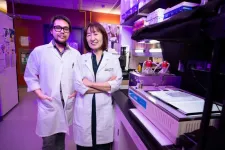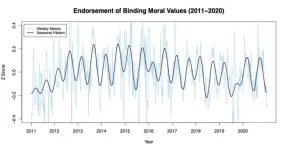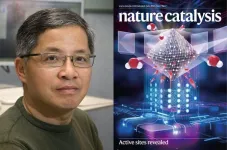(Press-News.org)
Millions of Americans consume supplements that contain potentially hepatoxic botanical ingredients, according to a study from University of Michigan researchers.
Over a 30-day period, 4.7% of the adults surveyed in the National Health and Nutrition Examination Survey conducted from 2017 to 2020 took herbal and dietary supplements containing at least one of the botanicals of interest: turmeric; green tea; ashwagandha; black cohosh; garcinia cambogia; and red yeast rice containing products.
The resulting paper, “Estimated Exposure to 6 Potentially Hepatoxic Botanicals in US Adults,” appeared in JAMA this month.
“Our interest started when we saw cases of liver toxicity from herbal and dietary supplement use in people enrolled into the ongoing NIH-funded DILIN study,” said Alisa Likhitsup, M.D., M.P.H., clinical assistant professor of Medicine at U-M and lead author on the paper.
“But it was difficult to say how many people were using these supplements and why. The major finding here is the large number of Americans taking these products with an estimated 15 million adult Americans taking them on a regular basis.”
Prior research in the field had established the specific botanicals studied as potentially hepatoxic.
Supplements are of particular concern for the researchers for several interrelated reasons: lack of government regulation, insufficient attention in medical screenings, and frequent mislabeling.
“In a previous study, we found that there was a great deal of mislabeling of some of these products,” said Robert Fontana M.D., Michigan Medicine hepatologist, professor of medicine and the study’s senior author.
“We performed analytical chemistry and found about a 50% mismatch between stated ingredients on the label and what they actually contained, which is quite alarming. If you buy a supplement and it says it has a certain ingredient, it's basically a coin flip if that’s true or not.”
Mislabeling is enabled by lack of regulation. And since their effects are not well understood, clinicians often will not ask patients what supplements they are taking.
“We weren't aware that so many people were taking these supplements,” said Likhitsup, a transplant hepatologist.
“So, when doctors see patients in the office, they don't necessarily ask about supplement use or take into consideration their effects.”
In the studied population, the highest proportion of people consumed turmeric (3.46%), followed by green tea (1.01%), ashwagandha and black cohosh (0.38%), garcinia cambogia (0.27%), and red yeast rice products (0.19%).
Most users reported consuming the botanicals on their own and not on the advice of a doctor.
The most common reason given for taking the botanicals was to improve or maintain health.
Of the turmeric users, 26.8% consumed the products specifically for supposed benefits for joint health or arthritis, while 27.2% of the green tea users were hoping to improve their energy levels.
The majority of the garcinia cambogia users hoped it would help them lose weight.
One impetus for this research is the growth of herbal and dietary supplements industry.
The paper notes that there are more than 80,000 unique supplement products available for purchase worldwide and that supplement sales surpassed $150 billion in the United States in 2023, a figure that rivals the combined sales of prescription drugs.
Another study had found a 70% increase in liver transplants due to injury caused by supplements from 2010-2020, compared to 1994-2009.
The JAMA study was not able to establish any kind of causal relationship between consumption of the six botanicals and liver injury since it was intended to assess supplement exposure in the general U.S. population. Given the lack of regulation, however, the researchers still hope to make clinicians and patients aware of just how much is still unknown about these supplements.
“We're not trying to create alarm,” Fontana said.
“We're just trying to increase awareness that the over-the-counter supplements people are taking and buying have not been tested nor necessarily proven to be safe.”
Additional authors: Vincent L. Chen, M.D., M.S.
Michigan Research Cores: Informatics, Statistics, and Computation
Paper cited: “Estimated Exposure to 6 Potentially Hepatoxic Botanicals in US Adults,” JAMA. DOI: 10.1001/jamanetworkopen.2024.25822
END
Sometimes you just can’t win, and that goes double for people navigating the increasingly polarized political landscape in the United States.
Having nuanced opinions of politics in the U.S. turns out to be a very lonely, and unpopular, road, according to a recent study from a research team that includes assistant professor Aviva Phillipp-Muller from Simon Fraser University’s Beedie School of Business.
Published in the Journal of Experimental Social Psychology, the study found that people who express ambivalence about political topics – ranging from COVID-19 mask mandates, immigration and the death ...
EL PASO, Texas (Aug. 6, 2024) – Grab a drink with friends at happy hour and you’re likely to feel chatty, friendly and upbeat. But grab a drink alone and you may experience feelings of depression. Researchers think they now know why this happens.
“Social settings influence how individuals react to alcohol, yet there is no mechanistic study on how and why this occurs,” said Kyung-An Han, Ph.D., a biologist at The University of Texas at El Paso who uses fruit flies to study alcoholism.
Now, Han and a team of UTEP faculty and students have taken a key step in understanding the neurobiological process behind social drinking and how it boosts ...
A team of researchers, led by the University of Houston, has discovered two new ways of preventing and treating respiratory viruses. In back-to-back papers in Nature Communications, the team - from the lab of Navin Varadarajan, M.D. Anderson Professor of William A. Brookshire Chemical and Biomolecular Engineering - reports the development and validation of NanoSTING, a nasal spray, as a broad-spectrum immune activator for controlling infection against multiple respiratory viruses; and the development of NanoSTING-SN, a pan-coronavirus nasal vaccine, that can protect against infection and disease by all members of the coronavirus family.
NanoSTING ...
A new UBC study has revealed regular seasonal shifts in people’s moral values.
The finding has potential implications for politics, law and health—including the timing of elections and court cases, as well as public response to a health crisis.
The research published this week in Proceedings of the National Academy of Sciences (PNAS) analyzed survey responses from more than 230,000 people in the U.S. over 10 years and revealed that people’s embrace of certain moral ...
The chemical and energy industries depend upon catalysts to drive the reactions used to create their products. Many important reactions use heterogeneous catalysts — meaning that the catalysts are in a different phase of matter than the substances they are reacting with, such as solid platinum reacting with gases in an automobile’s catalytic converter.
Scientists have investigated the surface of well-defined single crystals, illuminating the mechanisms underlying many chemical reactions. However, there is much more to be learned. For heterogeneous catalysts, their 3D atomic structure, their chemical composition and the nature of ...
When we’re sick, the first step on the road to recovery is a visit to the doctor’s office.
It turns out the same may also be true for breathing life into America’s democracy.
A Rutgers University–New Brunswick study published in the journal JAMA Health Forum finds that physicians can play a crucial role in strengthening political inclusion of marginalized groups by aiding patients in voter registration.
“Hospitals aren’t the first place we think of when it comes to voter registration,” said Katherine McCabe, an associate professor of American politics at Rutgers University-New Brunswick and lead ...
Electronic waste, or e-waste, is a rapidly growing global problem, and it’s expected to worsen with the production of new kinds of flexible electronics for robotics, wearable devices, health monitors, and other new applications, including single-use devices.
A new kind of flexible substrate material developed at MIT, the University of Utah, and Meta has the potential to enable not only the recycling of materials and components at the end of a device’s useful life, but also the scalable manufacture of more ...
Working with human stem cells that form a kind of “mini intestine-in-a-dish,” Johns Hopkins Medicine scientists say they have found several molecular mechanisms for COVID-19-related diarrhea, suggesting potential ways to control it.
Details of the experiments in a model of human intestinal tissue, called enteroids, are described on July 30 in Cellular and Molecular Gastroenterology and Hepatology.
Along with the unpleasant aches, fever, sore throat, cough, respiratory distress and other symptoms that may accompany COVID-19 infection, up to half of people who get the virus will experience diarrhea. Some 30% of them will go on to develop ...
Leuven, 6 August 2024 - A team of researchers from the lab of Prof. Stein Aerts (VIB-KU Leuven) presents Nova-ST, a new spatial transcriptomics technique that promises to transform gene expression profiling in tissue samples. Nova-ST will make large-scale, high-resolution spatial tissue analysis more accessible and affordable, offering significant benefits for researchers. The research was published in Cell Reports Methods.
Transcriptomics is the study of gene expression in a cell or a population of cells, but it usually does not include spatial information about where those genes were active. This hurdle limited our understanding of complex ...
BUFFALO, NY- August 6, 2024 – On July 28, 2024, Mikhail V. Blagosklonny M.D., Ph.D., from Roswell Park Comprehensive Cancer Center published a new editorial in Volume 16, Issue 14 of Aging (listed by MEDLINE/PubMed as "Aging (Albany NY)" and "Aging-US" by Web of Science), entitled, “Targeted cancer therapy: the initial high concentration may slow down the selection for resistance.”
“Unfortunately, any targeted therapy is, always, started with low levels of the drug in the organism, selecting for drug resistance. One should propose that initial drug levels must be maximized, ...





